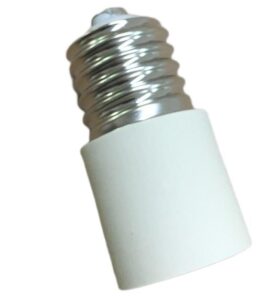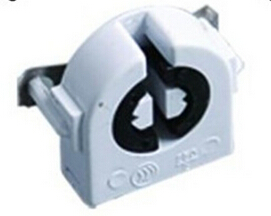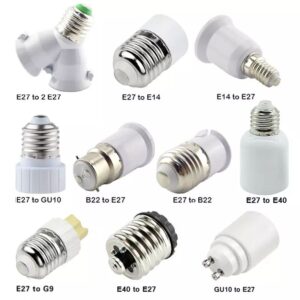Porcelain lamp sockets are used a lot because they have great heat resistance, they are durable, and they are good electrical insulators.
Porcelain lamp sockets are used a lot because they have great heat resistance, they are durable, and they are good electrical insulators. They are used in high-temperature lighting applications.
Let’s talk about why you want to use porcelain and how it compares to other options.

Why Use a Porcelain Socket?
Porcelain lamp sockets are widely favored because of their high durability and ability to withstand heat. Porcelain, as a material, is non-conductive and heat-resistant, which is critical for handling high-wattage bulbs. In environments where light fixtures are used for extended periods or where high temperatures are expected, porcelain sockets offer significant advantages.
They are also less likely to degrade or deform over time compared to plastic sockets, which can soften or melt under high heat. Moreover, porcelain’s insulation properties ensure safer operation by reducing the risk of electrical arcing, a common cause of fires. For both safety and longevity, porcelain sockets remain the superior choice for industrial and commercial lighting needs.
Are Porcelain Lamp Holders Better Than Plastic?
Porcelain lamp holders surpass plastic ones, especially in environments where durability and heat resistance are paramount. While plastic sockets are lightweight and more affordable, they are more prone to damage under high temperatures. Over time, plastic can become brittle or discolored, reducing the aesthetic appeal and functionality of the fixture.
Porcelain, on the other hand, maintains its structure and insulating properties even under extreme conditions. It can handle higher wattages without compromising safety, making it the preferred material for heavy-duty applications such as outdoor lighting and high-temperature areas. Therefore, for long-term performance and safety, porcelain lamp holders are typically better than plastic alternatives.
What Is the Most Common Lamp Socket?
The E26 and E27 sockets are the most commonly used lamp sockets worldwide. These sockets are standard in both residential and commercial lighting setups. The E26 socket, primarily used in North America, and the E27 socket, widely used in Europe and Asia, are nearly identical, differing only by a millimeter in diameter.
Both are screw-type sockets, making them easy to install and replace. These sockets are compatible with a vast array of bulbs, including LED, incandescent, and halogen, making them versatile for various lighting solutions.

Do Porcelain Light Fixtures Get Hot?
Yes, porcelain light fixtures do get hot, but they are designed to withstand higher temperatures than plastic or other materials. The high heat resistance of porcelain means that even under continuous operation or in high-wattage applications, the material can dissipate heat more effectively without warping or melting.
This is why porcelain sockets are used in environments where high temperatures are common. However, even though they are more heat-tolerant, it is still essential to ensure that the fixture is installed in well-ventilated areas to avoid overheating and to extend the lifespan of both the socket and the bulb.
How Can You Tell If a Lamp Is Vintage?
Determining whether a lamp is vintage involves assessing several features, including the design, materials, and type of socket used. Vintage lamps often have more intricate and handcrafted designs, using materials like brass, porcelain, or glass. The socket itself can be a giveaway — older lamps typically use screw-type sockets, such as E26 or E27, made from porcelain or bakelite, rather than modern plastic.
Another way to tell is by looking at the wiring. Vintage lamps often have cloth-covered wiring, while modern lamps use plastic insulation. Checking for manufacturer labels or certifications stamped on the socket or fixture can also help identify the age of the lamp.
What Are the Two Types of Lamp Sockets?
The two main types of lamp sockets are screw-type and pin-type. Screw-type sockets, like the E26 and E27, are the most common and are used in many household and commercial light fixtures. These sockets allow bulbs to be screwed in easily, offering a secure and stable connection.
Pin-type sockets, such as GU10 or MR16, are commonly used for more specialized lighting applications, including spotlights and recessed lighting. These sockets rely on pins inserted into matching holes, providing a different connection method that is typically seen in halogen and LED lighting systems.

What Type of Sockets Are the Most Commonly Used?
Screw-type sockets, particularly the E26 and E27, are the most commonly used sockets globally. These sockets are widely found in residential, commercial, and industrial applications because of their ease of use and compatibility with a wide range of bulbs.
In addition to their widespread use, screw-type sockets are favored for their secure connection, making them suitable for both low-wattage and high-wattage bulbs. The versatility and availability of these sockets make them a staple in lighting fixtures across the world.
What Is a Phenolic Socket vs Porcelain Socket?
A phenolic socket is made from phenolic resin, a type of plastic that is durable and resistant to moisture and chemicals. Phenolic sockets are often used in budget-friendly light fixtures, where cost is a concern. However, while they are affordable, phenolic sockets are less heat-resistant compared to porcelain sockets.
Porcelain sockets, on the other hand, are made from ceramic material, which can withstand higher temperatures and offer better insulation. This makes porcelain the better choice for high-wattage applications or areas where heat is a concern. Phenolic sockets are suitable for lower-wattage applications but may not last as long under continuous use in demanding environments.

What Is the Difference Between E26 and E27?
The primary difference between E26 and E27 sockets is their diameter. E26 sockets, commonly used in North America, have a diameter of 26 millimeters, while E27 sockets, widely used in Europe and Asia, have a diameter of 27 millimeters. Despite this small difference, both socket types are interchangeable in most cases because the 1-millimeter size variation is negligible for most light fixtures.
Both socket types support a wide range of bulb types, including LED, incandescent, and compact fluorescent, making them versatile for various lighting applications. As a result, both E26 and E27 sockets are commonly found in residential and commercial settings.
Porcelain lamp sockets remain a trusted choice for high-heat, durable, and safe lighting applications.













